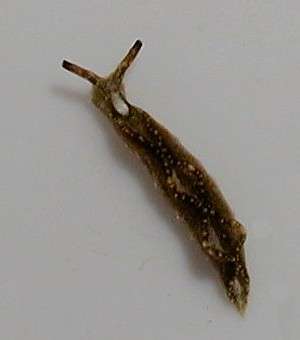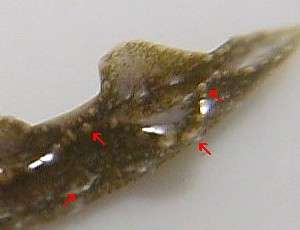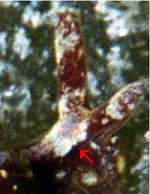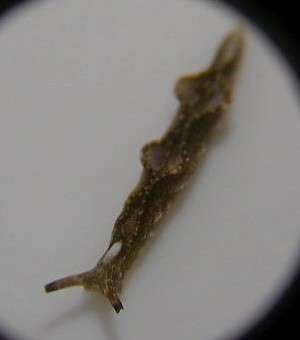
Elysia setoensis
Hamatani, 1968
Order: SACOGLOSSA
Superfamily: ELYSIOIDEA
Family: Elysiidae
DISTRIBUTION
Japan.
PHOTO
Miura Peninsula, Japan. Length approx 10mm. Crawling on seaweed in 1m water. PHOTO: Satoru Hori.
See message below.
Reference:
• Hamatani, I. (1968) A new species of Elysia from Kii, Japan (Opisthobranchia - Sacoglossa). Publications of the Seto marine Biological Laboratory, 16(1): 51-54.
Rudman, W.B., 2000 (March 13) Elysia setoensis Hamatani, 1968. [In] Sea Slug Forum. Australian Museum, Sydney. Available from http://www.seaslugforum.net/find/elysseto
Related messages
Elysia setoensis - feeding observations
May 14, 2000
From: Cynthia D. Trowbridge
Dear Bill,
Hi. Last month I asked about algal hosts of Elysia setoensis - I now can share some details. I am working in Japan with Dr. Yoshi Hirano. Last week I found two specimens of E. setoensis on the encrusting green algal host Codium adhaerens (which is common on low intertidal and subtidal rocky shores in Japan). In lab experiments, the slug also feeds on the upright, dichotomously branching Codium fragile. The specimens were found in front of the Misaki Marine Biological Station on the Miura Peninsula (the region that Satoru Hori found the species). E. setoensis is considerably smaller than the coexisting Elysia trisinuata.
All the best.
Cordially,
Cynthia Trowbridge
Hatfield Marine Science Center
Oregon State University
trowbric@ucs.orst.edu
Trowbridge, C.D., 2000 (May 14) Elysia setoensis - feeding observations. [Message in] Sea Slug Forum. Australian Museum, Sydney. Available from http://www.seaslugforum.net/find/2384Dear Cynthia,
Thanks for the information. A photo of E. trisinuata would be very helpful. I at times find animals which look like Baba's illustrations, but I am not totally convinced.
best wishes,
Bill Rudman.
Re: Elysia setoensis from Japan
April 9, 2000
From: Cynthia Trowbridge
Dear Bill,
Thank you for your recent description about how to identify this species. I was wondering if you or any of your readers would know the algal diet of this species? Satoru Hori mentioned that the was crawling on seaweed. Given the feeding specificity of sacoglossans, it would be very interesting to know the algal host on which to find the slugs. It is wonderful to learn more about the Japanese fauna. Thank you so much for sharing all the recent Elysia photos!
Cordially,
Cynthia Trowbridge
Oregon State University
trowbric@ucs.orst.edu
Trowbridge, C., 2000 (Apr 9) Re: Elysia setoensis from Japan. [Message in] Sea Slug Forum. Australian Museum, Sydney. Available from http://www.seaslugforum.net/find/2232Dear Cynthia,
Although I didn't plan it, all the messages today are about sacoglossans! You can pretend it's your birthday.
Bill Rudman.
Re: Elysia setoensis from Japan
March 19, 2000
From: Satoru Hori


Dear Bill
Thanks for your prompt reply.
I attach enlarged image files. Can you see the white tipped papillae on the parapodia and along the parapodial edge, and the head wart?
Is it sure to be Elysia setoensis ?
Best regards,
Satoru Hori.
ik8s-hr@asahi-net.or.jp
Hori, S., 2000 (Mar 19) Re: Elysia setoensis from Japan. [Message in] Sea Slug Forum. Australian Museum, Sydney. Available from http://www.seaslugforum.net/find/2096Dear Satoru,
Thanks for the enlarged photos. I have cut out the back half of your photo of the whole animal. It clearly shows the raised tubercles (arrows) on the sides and edge of the parapodia.
The head wart in the lower photo is not so clear. I am not sure whether the white region is a raised lump or just a white patch.
As far as I can tell this is Elysia setoensis although I must say I have never seen this species alive and am relying on published descriptions.
Best wishes,
Bill Rudman.
Elysia setoensis from Japan
March 14, 2000
From: Satoru Hori


Dear Bill,
I attached 2 image files. I think it is a kind of Elysia. But I can not find it in the seaslug guide books that I have.
Would you identify it for me?
Its length is about 10mm.
It was found at Miura Peninsula in Japan.
It was crawling on seaweed at 1m depth.
Best regards,
Satoru Hori.
ik8s-hr@asahi-net.or.jp
Hori, S., 2000 (Mar 14) Elysia setoensis from Japan. [Message in] Sea Slug Forum. Australian Museum, Sydney. Available from http://www.seaslugforum.net/find/2086Dear Saturo,
I think this is Elysia setoensis which was described from Kii, Japan. The characteristic features of that species are white tipped papillae on the parapodia and along the parapodial edge, and a large white 'wart' on the neck behind the rhinophores. Hamatani also says that 'the parapodial margins are apt to form a series of three imconspicuous lobes'.
It is a little hard to be sure from your photos, but I can see the white-tipped parapodial papillae at least on the left side of your photos, and I preseum the white spots along the parapodial edge are on papillae. The large white patch I can see in the photos, behind the rhinophores, is presumably the 'neck wart'. If any of these features are clearer in other photos you have perhaps you could send me a scan to clarify my identification.
Best wishes,
Bill Rudman.
